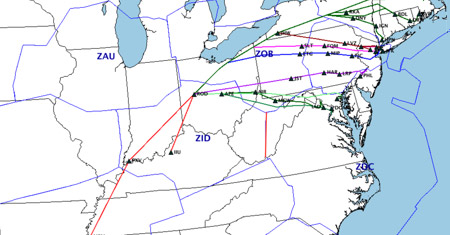

Oct. 2, 2017
Each day in the National Airspace System is different, but one constant is that the FAA wants aircraft operators to file flight plans with good routes. The FAA’s Air Traffic Control System Command Center can help expedite traffic flows by recommending or requiring certain routes to operators, and using them can help mitigate delays.
The Command Center not only develops required routes for special events and the yearend holidays; it issues route advisories almost daily.
Each advisory includes the route name, the constrained area, the reason for the constraint, types of traffic and facilities that should be included, time in effect, probability of extension, remarks and associated restrictions.
There are several places on the FAA’s website to find information on daily routes:
- The Advisories Database, where route advisories can be viewed as they are issued.
- The “Operations Plan’ advisory, which lists routes currently in use, along with routes that may be used later.
- The Current Reroutes page, which only shows the active reroutes. The advantage of using this particular FAA online resource is that you won’t have to search the Advisories Database.
Why are reroutes important? Because the Command Center manages the flow of traffic mainly by using “Playbook Routes” – a set of standard routes that are utilized when the preferred routes aren’t available. View the playbook, which lists routes currently in use, along with routes that may be used later.
There are two different types of routes: required reroutes (REQ) and recommended routes (RMD).
Operators that want to get through a constrained area and are considered “included traffic” according to the advisory must fly required reroutes. Operators that cannot fly a required reroute must inform ATC before departing, and, in some cases, will be delayed substantially.
RMD are the Command Center’s way of strongly suggesting that flying those routes will take operators out of a constrained area, which may reduce delays. Sometimes, if not enough operators use the recommended routes, they become required.
However, some routes are never required. For example, the AZEZU route takes aircraft into New York Oceanic airspace (ZWY), which has certain equipage requirements. However, AZEZU is a recommended route because it relieves inland traffic along the East Coast.
AZEZU also can be used as a “route out option” for airspace flow programs (AFPs). By going out into ZWY airspace, this route takes traffic around the east end of most of the common AFPs.
Canadian routes (CAN) also can be used as “route out options” for traffic traveling through Cleveland Center into the Northeast, or when normal transcontinental traffic is disrupted by Midwestern thunderstorms.
Remember, routes specifically designated as “route out options” must be filed exactly as noted in the route advisories. This is the only way that the system will exempt a flight from expected departure clearance times (EDCTs) associated with flights through an AFP.
Speaking of EDCTs, if you are caught in a ground delay program, do not refile to obtain a required or recommended route. Doing so will cause you to be classified as a pop-up flight, which likely will increase your delay. Instead, expect ATC to put you on the required route. Alternatively, you can request a recommended route. The same goes for a flight caught in an AFP: do not refile unless doing so will get you out of the AFP.
Understanding how to use routes is important. While some of these routes may be longer, utilizing them can reduce delays.
Direct questions to NBAA Air Traffic Services at airtraffic@nbaa.org.
This article originally appeared in the September/October 2017 issue of Business Aviation Insider.
Download the magazine app for iOS and Android tablets and smartphones.


 International Business Aviation Council Ltd.
International Business Aviation Council Ltd.